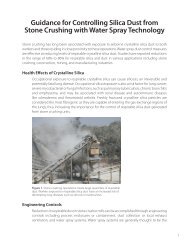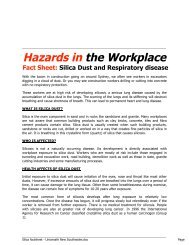Safety & Health in the Stone Crushing Industry - Occupational ...
Safety & Health in the Stone Crushing Industry - Occupational ...
Safety & Health in the Stone Crushing Industry - Occupational ...
Create successful ePaper yourself
Turn your PDF publications into a flip-book with our unique Google optimized e-Paper software.
10<br />
In <strong>the</strong> follow<strong>in</strong>g chapters we will take up <strong>the</strong>se topics one by one. We will discuss and describe<br />
solutions to reduce <strong>the</strong> risk of gett<strong>in</strong>g sick <strong>in</strong> stone crush<strong>in</strong>g. We have to keep <strong>in</strong> m<strong>in</strong>d <strong>the</strong> ALL of <strong>the</strong>se<br />
causes can essentially be reduced and controlled. But first, we look at <strong>the</strong> management side of safety<br />
and health. The unit owner has a very important role <strong>in</strong> f<strong>in</strong>d<strong>in</strong>g <strong>the</strong> risks, decid<strong>in</strong>g where improvements<br />
are necessary and feasible as well as <strong>in</strong> manag<strong>in</strong>g <strong>the</strong> improvement process and <strong>the</strong> role.<br />
A.1 A Word for <strong>the</strong> Owners: Manag<strong>in</strong>g <strong>Health</strong> and <strong>Safety</strong><br />
<strong>in</strong> <strong>Stone</strong> Crush<strong>in</strong>g<br />
Ralf Ste<strong>in</strong>berg, health & safety manager, Düsseldorf Germany<br />
Manag<strong>in</strong>g health and safety is little different from manag<strong>in</strong>g any o<strong>the</strong>r aspect of your bus<strong>in</strong>ess. You<br />
need to assess risks beforehand <strong>in</strong> your workplace, put sensible and cost-effective measures <strong>in</strong> place<br />
to reduce risks, and make sure <strong>the</strong>y stay low. This booklet will provide you with relevant <strong>in</strong>formation<br />
concern<strong>in</strong>g hazards and <strong>the</strong>ir control for operations <strong>in</strong> stone crush<strong>in</strong>g.<br />
What is a "risk assessment"?<br />
In order to reduce health risk and prevent<br />
accidents, you first have to assess risk. It helps<br />
you understand <strong>the</strong> nature of hazards, how your<br />
employees could be harmed and how you can<br />
prevent that from happen<strong>in</strong>g. It is noth<strong>in</strong>g more<br />
than a careful exam<strong>in</strong>ation of work<strong>in</strong>g conditions<br />
and <strong>the</strong> way workers could be harmed. It is a<br />
practical exercise, aimed at gett<strong>in</strong>g practical<br />
results. At <strong>the</strong> end, it helps you to focus on <strong>the</strong><br />
greatest risks first and set priorities for your<br />
actions. Most often, it means that simple, cheap<br />
Hazard?<br />
and effective measures are feasible to ensure<br />
your most valuable asset – your workforce – is<br />
protected. The step-by-step guidance below<br />
shows you how to assess health and safety risks<br />
with m<strong>in</strong>imum fuss.<br />
Five steps of risk assessment<br />
Operation<br />
Workplace =<br />
Equipment +<br />
Environment<br />
People<br />
Step 1: Identify <strong>the</strong> hazards<br />
Step 2: Decide who might be harmed<br />
and how<br />
Step 3: Evaluate <strong>the</strong> risks and decide on precautions<br />
Step 4: Record your f<strong>in</strong>d<strong>in</strong>gs and implement <strong>the</strong>m<br />
Step 5: Review your assessment and update if necessary<br />
Don’t overcomplicate <strong>the</strong> process. You probably already know whe<strong>the</strong>r, for example, you have<br />
employees who move heavy loads and so could harm <strong>the</strong>ir backs, or where people are most likely to<br />
slip or trip. If so, check that you have taken reasonable precautions to avoid <strong>in</strong>jury.<br />
You can do <strong>the</strong> assessment yourself. We provide you with checklists at <strong>the</strong> end of this manual to help<br />
you <strong>in</strong> this process (see chapter Checklists). You do not have to be a health and safety expert. If you<br />
are not confident, get help from someone who is competent. In all cases, you should make sure that<br />
you <strong>in</strong>volve your staff or <strong>the</strong>ir representatives <strong>in</strong> <strong>the</strong> process. They will have useful <strong>in</strong>formation about







